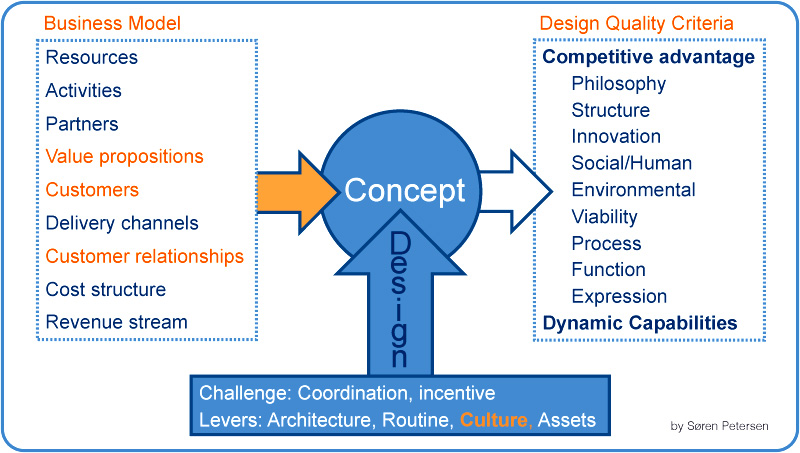
Co-written by Sabine Brunswicker.
Business Models are the corporate blueprints for generating revenue. Unfortunately, many of these models are intended for static business environments and often outmoded in today's competitive landscape. Developing innovative business models and low-cost methods for establishing their validity and action ability can, therefore, offer huge competitive advantages. However, unless one is able to translate this model into an inspirational design brief, the model is worthless.
Business models traditionally consist of nine basic elements: Resources, activities, partners, value propositions, customers, delivery channels, customer relationships, cost structure and revenue stream. Including design in business model experimentation facilitates the translation of the models into Design Quality Criteria. Designers can then synthesize concepts for products with a distinct competitive advantage in the marketplace. Studies show that an upfront inclusion of design increases revenue and these findings only scratch the surface of what design can contribute (think Apple, BMW, Nike, etc.) So, what exactly can design contribute to the business model creation process?
"Design is a creative activity, whose aim is to establish the multi-faceted qualities of objects, processes, services and their systems in whole life-cycles." Designers apply a design process to create new products by leveraging their understanding of a broad spectrum of industries, users and cultures. They investigate and communicate the product's meaning to the user by combining their knowledge and experience with a broad range of design languages. They also define the users' interaction with the product, service and experience through simulation and user testing. This creative design process results in meaningful and beautiful products.
Leveraging designers' competencies when creating business models remains uncharted territory. To obtain insights into what the design community believes it can contribute, we launched an online crowdsourcing challenge on an online social networking platform. We collected over forty comments from eight user groups ranging from design researchers; educators, practitioners and design managers. These conversations provided a rich discussion and three key insights:
1) Designers' visual communication, cross-pollinization and lateral thinking make them ideal facilitators of business model creation. A designers' unique ability to visualize concrete and abstract ideas enables them to clarify concepts as opposed to merely simplifying them. They can synthesize concepts from diverse information and propose concepts for team discussion. In some cases, they may even be able to assist in prototyping business models before substantial time and money are invested.
2) Design, being the hub of new product development, offers the opportunity to ensure alignment of stakeholder interest though the process from business model to final delivery while securing design cohesiveness.
3) Product positioning and expression of brand values is an area where design experts have extensive knowledge and experience. Design can ensure that brand considerations are included in the business model and expressed cohesively across all touch-points of the user experience.
Besides contributing to the creation of business models, designers can also ensure the models are actionable. The question to be asked is what new capabilities do designers need to create design value in business model concepts and to co-create innovative business models?
Special thanks to Sabine Brunswicker for researching and co-writing this article.